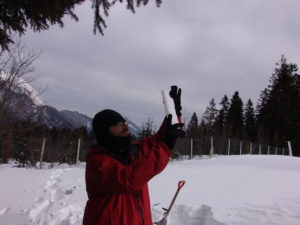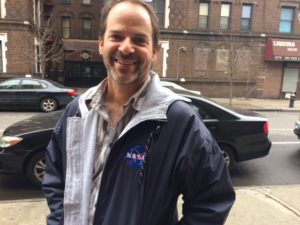
Earth System Scientist Charles Zender, a computer scientist, studies the ways pollution and climate change have affected ice, oceans, and other parts of this planet.
What forms of pollution have you noticed and how they have affected you and people you know?

On July 21, 1982, Antarctica’s weather reached the coldest temperature ever recorded: -128.5 degrees Fahrenheit / -89.2 degrees Celsius. Northice, Greenland reached the coldest temperature recorded in the western hemisphere: -87 degrees Fahrenheit / -66.1 degrees Celsius.
Very cold temperatures keep water in places like Antarctica and Greenland frozen. Their sheets of ice and snow are the part of the Earth known as the cryosphere. Why has the ice sheet over Greenland been melting faster in recent years?
That ice “is getting darker so quickly, it’s scary,” according to Earth System Scientist Charles Zender. He uses math and information gathered by environmentalists and economists to build models that predict ways the climate will change. Zender and other climate predictors study the reflectance of Greenland’s ice pack, noting that its ability to reflect light has decreased by about 10% in recent years. They propose different theories about why this is happening, suggesting that aging, warmer air, and pollution are all making the ice less reflective.

Zender finds “the pollution-driven hypothesis to be very interesting. We get to see the astonishingly important role that humans are playing, interfering with the reflectance of the ice sheet from what they do thousands of kilometers upwind.”
Dust gets blown into the atmosphere when people wear out and disturb the soil. When that dust falls into the ocean or on land, it may be harmless. “But when it falls on the ice sheet, it has more impact.” Emissions from industry in Europe, Asia, and North America also reduce reflectance. Zender tells Math4Science that fuels burned in the industrialized world affect the Arctic “more than you would have ever thought possible.” Impurities sampled from annual layers of snow compacted into ice cores indicate that Greenland was at its dirtiest in 1910-15, when smokestacks in northeastern North America sent particles released by burning coal into Earth’s atmosphere.
Zender and his team constructed models of the snowpack that sits atop ice sheets, working on a small scale to figure out how soil and soot affect the ways snow reflects light and how temperature affects individual snowflakes. “What we found is that the evil twin of global warming is particulate pollution.”
Working in the French Alps, they examined hockey puck-sized samples of compressed snow with optical lasers. Zender was “chilled to the bone,” despite the gloves and heavy coat he wore in the cold room, where it was -15 degrees Celsius (that’s 5 degrees Fahrenheit). At one point, he stayed in the room too long and his fingertips turned white. “I am Caucasian … but these were really white: I had frostbite!” Yet Professor Zender remembers that day as part of “one of the most rewarding years I’ve ever spent.”
As a child, Charlie “loved mythology, the stories behind the names of the constellations as much as later I loved the strange creatures, like black holes and red giants and blue dwarfs, described in Scientific American.” In high school, his math teacher suggested that he apply for a program that gave him the opportunity to spend six weeks staying up late, observing asteroids and computing their orbits. Later, after studying math, astronomy, and physics, he realized that he could combine his interest in astrophysics with a focus on Earth’s atmosphere. “That’s how I ended up improving climate predictions for a living.”
Zender emphasizes the importance of differential equations in his field. “If we used more accurate and more stable solution methods for a lot of problems, we could simulate, say, 100 years of climate instead of the 10 years we simulate with cruder methods.” That would help Zender and his colleagues improve the models they design, models which help us understand and prepare for future changes in Earth’s climate.


